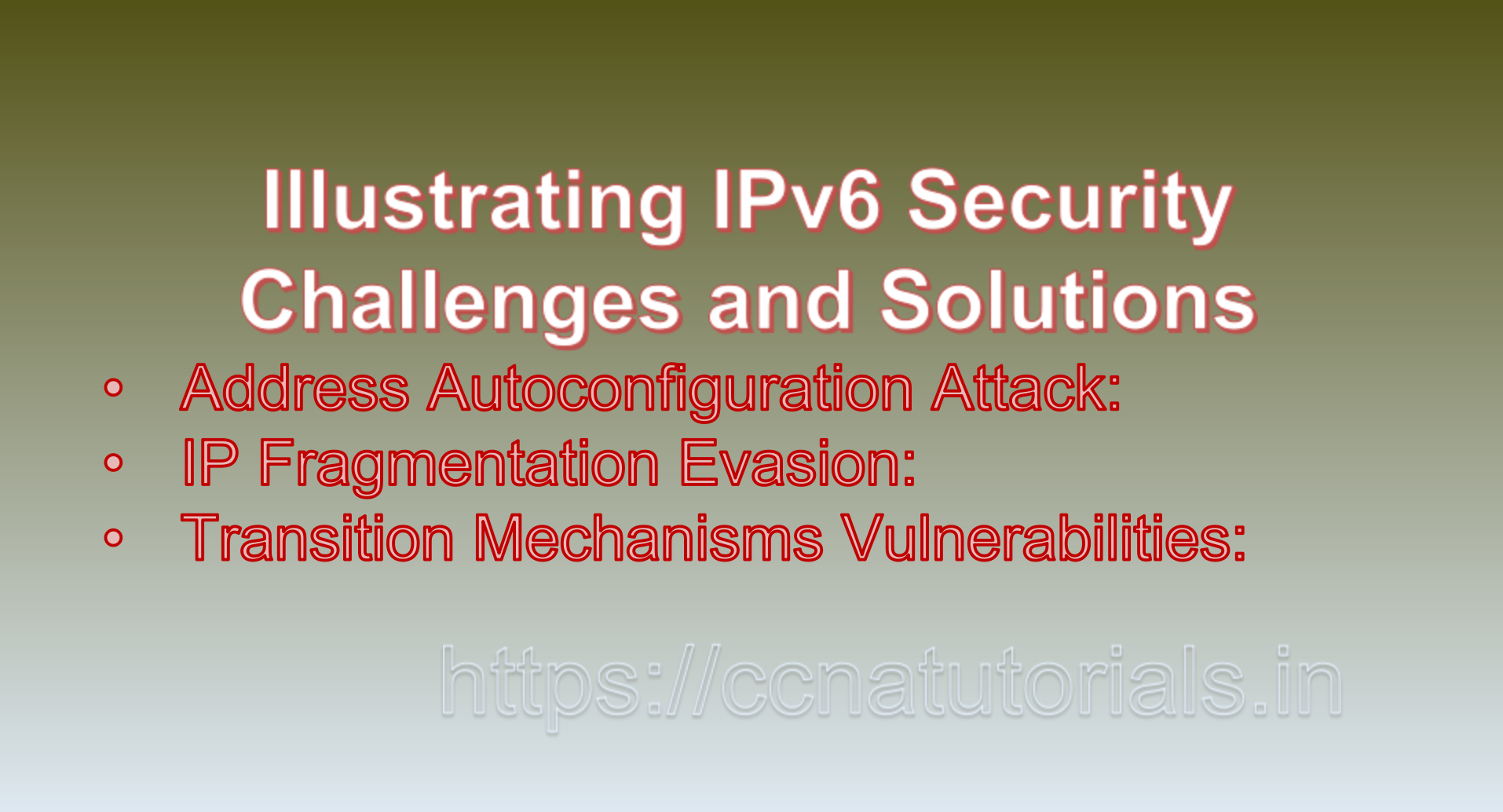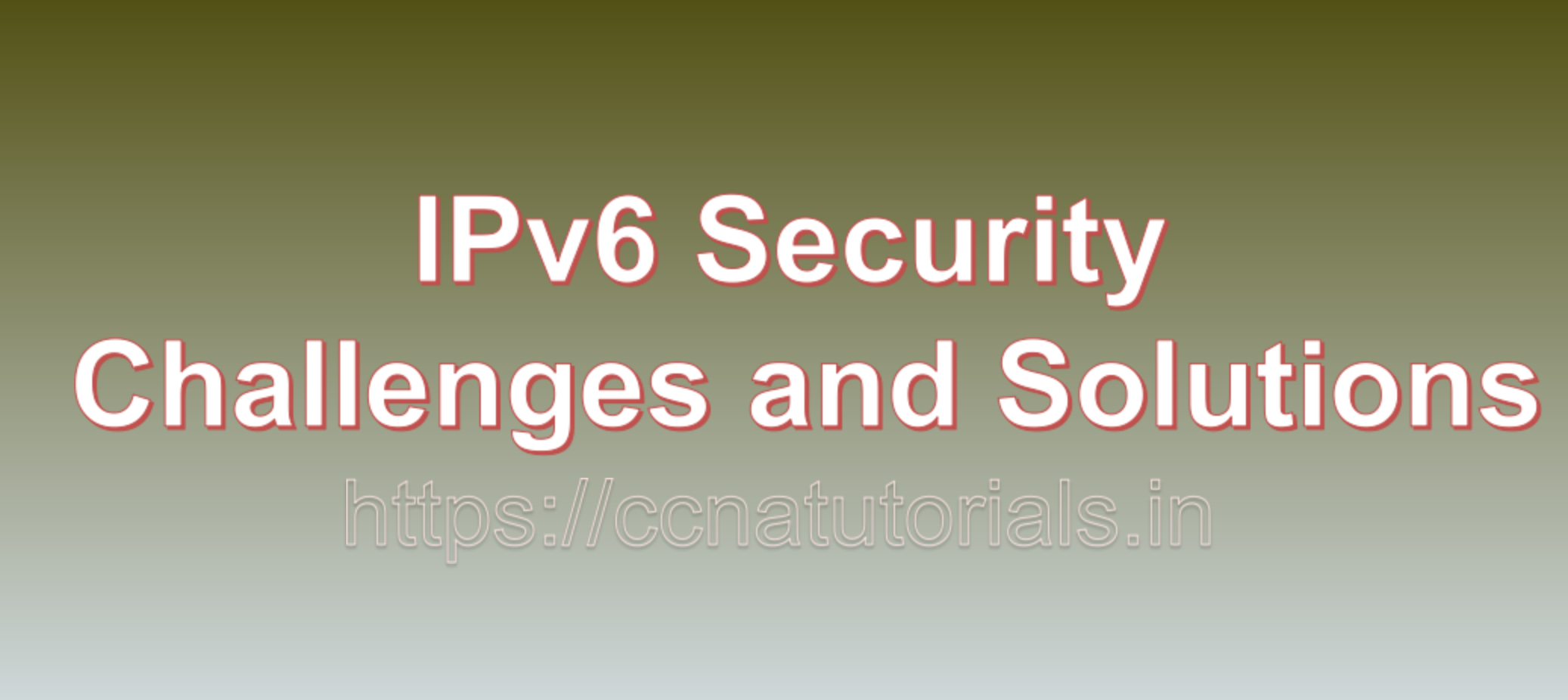Contents of this article
In this article, I describe IPv6 Security Challenges and Solutions: Ensuring Robust Network Protection. The transition to IPv6 (Internet Protocol version 6) brings about new security challenges and opportunities for organizations. While IPv6 offers enhanced features and a larger address space, its adoption introduces unique security considerations. This article will delve into the security challenges posed by IPv6 and present potential solutions to mitigate these risks. We will provide examples to illustrate the importance of addressing these challenges to ensure a secure and resilient network environment.
IPv6 Security Challenges
1. Address Space Abundance:
IPv6’s expansive address space complicates network scanning and tracking malicious activity. Attackers have more IP addresses to target, making traditional security mechanisms less effective.
2. Address Autoconfiguration:
IPv6 devices often autoconfigure their addresses, which can lead to unauthorized devices gaining network access. Attackers could exploit this to infiltrate networks undetected.
3. IP Fragmentation:
IPv6 allows for larger packet sizes, which might facilitate evasion of intrusion detection and prevention systems (IDS/IPS) by fragmenting malicious payloads.
4. Transition Mechanisms:
During the IPv4 to IPv6 transition, devices may rely on tunneling or translation mechanisms, potentially bypassing security controls and creating new attack vectors.
5. Lack of Experience:
Many IT professionals are more familiar with IPv4, potentially leading to misconfigurations and vulnerabilities specific to IPv6.
IPv6 Security Solutions
1. Network Segmentation:
Segment the network to prevent unauthorized access. Use firewalls and access control lists (ACLs) to control traffic between segments. This limits an attacker’s lateral movement.
2. Intrusion Detection and Prevention Systems (IDS/IPS):
Deploy IDS/IPS solutions that understand IPv6 traffic patterns. These systems can detect and prevent malicious activities while monitoring network traffic.
3. Address Management and Monitoring:
Maintain strict address management policies, keeping track of allocated addresses. Employ network monitoring tools to identify unauthorized or unusual IPv6 addresses.
4. Router Security:
Secure routers and switches with strong authentication, access controls, and regular firmware updates. These devices play a critical role in managing IPv6 traffic.
5. Firewall Rules Review:
Regularly review and update firewall rules to accommodate IPv6. Apply the principle of least privilege, allowing only necessary traffic.
6. IPv6-Ready Security Solutions:
Ensure that security products and appliances are IPv6-capable. Many security vendors now provide solutions designed for IPv6 environments.

Examples Illustrating IPv6 Security Challenges and Solutions
1. Address Autoconfiguration Attack:
Imagine an attacker leveraging IPv6’s autoconfiguration to gain unauthorized access to a corporate network. A solution would involve:
– Implementing network segmentation to isolate sensitive segments from less critical areas.
– Deploying IDS/IPS to monitor for unauthorized devices attempting to autoconfigure and gain network access.
– Regularly monitoring and auditing IPv6 addresses for unexpected devices.
2. IP Fragmentation Evasion:
An attacker may exploit IPv6’s larger packet sizes for malicious purposes, such as evading security systems. The solution involves:
– Configuring IDS/IPS systems to reassemble fragmented packets before analysis, mitigating evasion attempts.
– Applying rate limiting to fragmented packets to prevent abuse and ensure consistent traffic patterns.
3. Transition Mechanisms Vulnerabilities:
During IPv4 to IPv6 transitions, tunneling mechanisms might be exploited. The solution requires:
– Employing security controls specifically designed for tunneling protocols.
– Regularly reviewing tunneling configurations to ensure only authorized traffic is allowed.
Short description of IPv6 Security Challenges and Solutions
IPv6 security challenges present organizations with the need to adopt proactive measures to safeguard their networks. By understanding the unique risks introduced by IPv6, organizations can implement solutions that address these challenges effectively. Employing network segmentation, robust intrusion detection systems, and IPv6-ready security products are key steps in building a secure IPv6 environment. As the digital landscape evolves, a holistic approach to IPv6 security ensures that networks remain resilient and protected against emerging threats. By adopting best practices and leveraging security solutions specifically designed for IPv6, organizations can harness the benefits of IPv6 while maintaining a strong security posture.
IPv6 Security Challenges and Solutions: Navigating the Enhanced Landscape
The transition to IPv6 (Internet Protocol version 6) brings numerous benefits, including a larger address space and improved routing efficiency. However, along with these advantages come new security challenges that organizations must address to ensure the safety of their networks and data. In this article, we will explore the security challenges associated with IPv6 and provide solutions to mitigate these risks. We will also provide examples to illustrate how organizations can effectively secure their IPv6-enabled environments.
IPv6 Security Challenges
1. Address Space Complexity:
IPv6’s extensive address space can complicate network monitoring and management, making it harder to detect unauthorized devices or activities.
2. Lack of Network Visibility:
IPv6 tunnels and temporary addresses can reduce network visibility, potentially leading to blind spots in monitoring and security measures.
3. Transition Mechanisms:
Transition mechanisms from IPv4 to IPv6, such as dual-stack configurations and tunneling, can introduce security vulnerabilities if not properly configured and monitored.
4. Header Complexity:
IPv6 headers are more complex than those of IPv4, potentially leading to security vulnerabilities if not adequately examined.
5. Lack of Experience:
Many IT professionals are more familiar with IPv4, which may result in misconfigurations and misunderstandings about IPv6’s security features.
IPv6 Security Solutions
1. Comprehensive Network Monitoring and Logging:
Solution: Implement robust monitoring and logging tools to detect unauthorized devices, unusual network behavior, and potential threats.
Example: Deploy intrusion detection systems (IDS) and intrusion prevention systems (IPS) that monitor traffic patterns and identify anomalies in IPv6 traffic, providing insights into potential security breaches.
2. Network Segmentation and Segregated Subnets:
Solution: Divide the network into smaller segments and use segregated subnets for different types of devices. Apply appropriate security policies to control traffic flow between segments.
Example: Create separate IPv6 subnets for internal devices, guest networks, and IoT devices. Implement firewall rules to restrict communication between these segments, minimizing the attack surface.
3. Regular Security Audits and Assessments:
Solution: Conduct periodic security audits and assessments to identify vulnerabilities, misconfigurations, and potential security gaps in IPv6-enabled environments.
Example: Hire third-party security experts to perform penetration tests on IPv6 networks, simulating real-world attacks and identifying weaknesses that need to be addressed.
4. Secure Transition Mechanisms:
Solution: Properly configure and monitor transition mechanisms such as dual-stack configurations and tunneling protocols to prevent unauthorized access or data leakage.
Example: Implement strong authentication and encryption mechanisms for tunneling protocols like 6to4 or Teredo to ensure the security of data transmitted over IPv6 tunnels.
5. Enhanced Network Security Controls:
Solution: Deploy advanced security controls, including firewalls, intrusion detection systems, and intrusion prevention systems, specifically designed for IPv6 traffic.
Example: Use next-generation firewalls that understand IPv6 traffic and apply security policies based on IPv6 addresses and headers, providing robust protection against potential threats.
6. IPv6-Enabled Intrusion Detection and Prevention:
Solution: Utilize intrusion detection and prevention systems designed to handle IPv6 traffic and detect malicious activities.
Example: Deploy IPS/IDS solutions that have updated rule sets to analyze and block suspicious IPv6 traffic patterns, ensuring that your network is protected against both IPv4 and IPv6 threats.
7. Employee Training and Awareness:
Solution: Provide training to IT personnel and employees about IPv6 security risks, best practices, and the importance of maintaining security in a dual-stack environment.
Example: Offer workshops and seminars to educate employees about potential IPv6 security challenges, emphasizing the need for secure configurations and vigilant monitoring.
Conclusion for IPv6 Security Challenges and Solutions
IPv6 brings a new set of security challenges that organizations must address to ensure the integrity, availability, and confidentiality of their networks and data. By implementing comprehensive monitoring, secure configurations, regular assessments, and robust security controls, organizations can effectively mitigate IPv6-related risks. The key lies in proactive planning, training, and staying up-to-date with the latest security developments in both IPv4 and IPv6. As the world embraces the transition to IPv6, robust security practices will play an essential role in maintaining a secure and resilient digital ecosystem.
I hope you found this article helpful, you may drop a comment below or contact us for any query related to any topic on this website.






